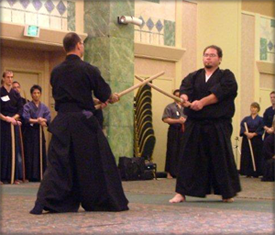
The Senkakukan was founded in 2006 by
William E. Henderson in Folsom California. The name Senkakukan, meaning "
pioneer dojo," was given to the school by Sensei Tony Alvarez & Sensei Renfield Kuroda.
Arts studied at the Senkakukan include Meishi-Ha Mugai Ryu Iaihyodo, Toyama Ryu Iai Do, Zen Nihon Batto Do Renmei (ZNBDR) Seitei, Dentokan Jujutsu & Uchida Ryu Tanjo Jutsu.
The Senkakukan school provides Japanese sword training and martial studies for Sacramento as well as Southern and Northern California.
History of Martial Studies
Dentokan Jujutsu
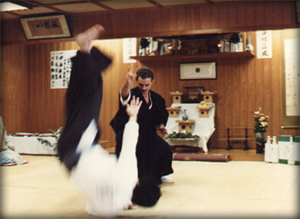
The Sekai Dentokan Bugei Renmei, Inc. (World School of Traditional Martial Arts Federation, Inc.), formerly known as the Kokusai Dentokan Bugei Renmei (International School of Traditional Martial Arts Federation), was founded in 1994 by Col (Ret) Roy J. Hobbs, Hanshi as a means of providing instruction, and certification, in the various martial arts he has studied and practiced for over 50 years. The Sekai Dentokan Bugei Renmei, Inc. is a member organization of the Zen Nihon Sogo Budo Renmei (All Japan Comprehensive Martial Arts Federation), located in Kyoto, Japan. Col Hobbs officially serves as an Advisor to the Zen Nihon Sogo Budo Renmei leadership.
Col Hobbs also serves as Shidoin, Nippon Seibukan Academy (NSA) - U. S. A. Branch, and Fuku Shibucho for NSA English Speaking Countries. Like the Zen Nihon Sogo Budo Renmei, the Hombu Dojo of the Nippon Seibukan Academy is located in Kyoto, Japan. The worldwide Dentokan and the NSA are both member organizations of the SoBuRen. As such they are mutually supportive of one another's Budo acitivities. Dentokan members are authorized to hold membership and office in the NSA.
Additionally, Col Hobbs serves as an Advisor to the Goju-Ryu Okinawakan Karate-Do Kyokai - North American Branch, the Ryukyu Dento Kobujutsu Hozon Budo Kyokai - North American Branch, and the International Goju-Ryu Karate Association - Pan American Branch. The Dentokan Hombu Dojo is a Life Member Dojo within the International Goju-Ryu Karate Association - Pan American Branch. Lastly, Col Hobbs is the State of Illinois Director for the Okinawa Goju-Ryu Karate-Do Kyokai - U. S. A. Branch.
+
Learn MoreMugai Ryu
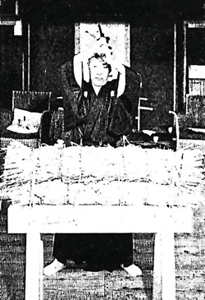
The founder, Tsuji Gettan (born Heinai) was born in the first year of Keian (1648 at the time of Tokugawa Iemitsu's Shogunate) in Umasugi Miyamura village in Omi province. At 13 years of age, he learned Yamaguchi-ryu kenjutsu from Yamaguchi Bokushinsai, the head of Yamaguchi-ryu at that time, in Kyoto. He was awarded menkyo (license) at 26 and left for Edo with his teacher's permission to open a Yamaguchi-ryu dojo in the Kojimachi district. No one took much notice of him, however, since he was a country warrior, so he trained only a handful of pupils. Heinai felt that he needed to cultivate his mind and studies, so he studied under Zen master Sekitan at Kyukoji in Azabu (Tokyo) where he learned about Zen and Chinese classics. He continued his studies under another Osho (monk) after master Sekitan passed away, and at 45 years of age Heinai attained enlightenment. He was given the following poem in master Sekitan's name.
Ippo jitsu mugai (There is nothing but the one truth.)
Kenkon toku ittei (It is universal, constant.)
Suimo hono mitsu (The wind-blown feather truly obtains this secret.)
Dochaku soku kosei (To know harmony amidst confusion is to be illuminated.)
Heinai became Gettan Sukemochi, and he created the name "Mugairyu" from the first line of this poem in the sixth year of Genroku (1693). Through his 20 years of zen training, he was no longer merely a sword master, he was also a zen practitioner and scholar, so it can be said that Gettan was an equal of the daimyo that visited Kyukoji as well. Among these daimyo were men such as Ogasawara Sadorinokami Nagashige, the Lord of Umayabashi; as well as Sakai Utanokami Tadataka, the Lord of Tosa; and Yamanouchi Toyofusa. In the eigth year of Genroku (1695), Gettan's home burned down in the great fire of Edo, so the number of his students until that time is unknown. According to the oaths sworn by his pupils during the fourteen years between the ninth year of Genroku (1696) and the sixth year of Hoei (1710), there were daimyo from 32 houses making over 10,000 koku, 156 jikisan (bushi under direct employ of the shogun), and 930 retainers.
Gettan hoped to live the life of a seeker of truth, so he declined the occassional opporunities extended to him to teach as a master instructor for various daimyo. However, he did send his nephew, the second generation Mugairyu soke Tsuji Uheita, to the Sakai family of the Umayabashi clan (later changed to the Himeji clan) to work as a master instructor. He also recommended that his adopted son, Tsuji Kimata Sukehide (who would later be the third generation Mugairyu soke) be sent to the Yamanouchi family in Tosa as their master instructor. Isoda Nagishi of the Sakai family of Iseizaki (a branch of the above mentioned Sakai family) learned from Uheita as well, and the teaching (he received) was passed down through the Naito family of the Komoro clan.
+
Learn MoreToyama Ryu (ZNTIR)
Zen Nihon Toyamaryu Iaido Renmei engages itself in activities to widely promote Japanese martial arts and culture through learning and training of Toyamaryu Iaido, not only in Japan but also abroad, and along with it activities including organizing international exchanges with overseas students of Japanese martial arts from countries such as the US, China, Hong Kong, Taiwan, and Spain.
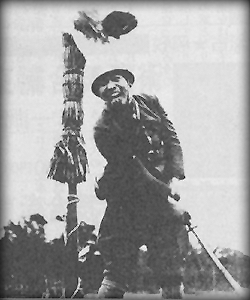
Toyamaryu Iaido is based on the Gunto Soho, a consolidated, improved, and officially adopted katana swordsmanship of the Toyama Military Academy of the Imperial Japanese Army. After the Second World War, it was referred to as 'Toyamaryu' and established as a school of traditional Japanese swordsmanship of Iaido, and it continues to pursue the height of the art and be modified today.
Since the process of consolidation, improvement, and establishment of the Gunto Soho took approximately twenty years, from the Taisho period till the end of the Second World War, and several sword masters from different schools were involved in its development by stages, Toyamaryu is not attributed to a single founder.
The Treaty of Peace with Japan (San Francisco Peace Treaty) was signed in 1951 and came into force in 1952. As Japan regained its independence and the martial arts ban was lifted, Morinaga Kiyoshi, the former director of sword fighting at the Toyama Military Academy, Yamaguchi Yuki, Nakamura Taizaburo, and others started to call the swordsmanship based on Gunto Soho 'Toyamaryu', disseminating it all over Japan.
The present Zen-Nihon Toyamaryu Iaido Renmei (ZNTIR) was started as 'Toyamaryu Shinko-kai', established by Tokutomi Tasaburo and Nakamura Taizaburo who used to teach Gunto Soho in the army. Over the course of time 'Toyamaryu Shinko-kai' was renamed to the 'Zen-Nihon Toyamaryu Iaido Renmei' and another organization, 'Zen-Nihon Batto-Do Renmei (ZNBDR)' was established in order to include other Batto art schools, driving Iaido as one organization with two federative wheels. In 2001, 'Zen-Nihon Batto-Do Renmei' and the 'Zen-Nihon Toyamaryu Iaido Renmei' were separated. While the 'Zen-Nihon Batto-Do Renmei' is an organization for various schools of Iaido, the 'Zen-Nihon Toyamaryu Iaido Renmei' is an independent organization, though a member of the former federation, with independent activities.
+
Learn MoreZen Nihon Batto Do Renmei (ZNBDR)
+ The Zen Nippon Batto Do Renmei was originally formed by Nakamura Taizburo Sensei in 1980. Recent Kaicho had included, Seiji Ueki Sensei, Hataya Mitsuo Yoshitoki Sensei, and currently
Sakaida Zeneimon Sensei.
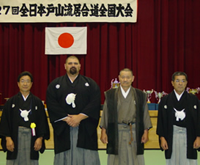
Bob Elder Sensei receives Rokudan Kiyoshi and Tony Alvarez receives Godan Renshi.
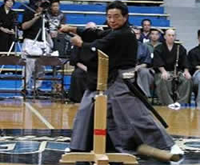
Sakaida Sensei Tameshigiri
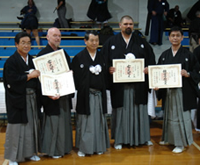
Sakaida Sensei, Alvarez Sensei, Ueki Sensei and Kobaiashi Sensei. All Japan Batto Do Renmei Taikai.
Senpokan
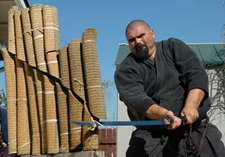
The Senpokan and its founder Big Tony Alvarez are dedicated in spreading the teaching and traditions of Mugai Ryu Iaihyodo Meishi-Ha, Toyama Ryu Batto Jutsu, Takamura-Ha Shindo Yoshin Ryu and the Seitei kata and waza of the Zen Nihon Batto Do Renmei.
+
Learn More
 The Senkakukan was founded in 2006 by William E. Henderson in Folsom California. The name Senkakukan, meaning "pioneer dojo," was given to the school by Sensei Tony Alvarez & Sensei Renfield Kuroda.
The Senkakukan was founded in 2006 by William E. Henderson in Folsom California. The name Senkakukan, meaning "pioneer dojo," was given to the school by Sensei Tony Alvarez & Sensei Renfield Kuroda. The Sekai Dentokan Bugei Renmei, Inc. (World School of Traditional Martial Arts Federation, Inc.), formerly known as the Kokusai Dentokan Bugei Renmei (International School of Traditional Martial Arts Federation), was founded in 1994 by Col (Ret) Roy J. Hobbs, Hanshi as a means of providing instruction, and certification, in the various martial arts he has studied and practiced for over 50 years. The Sekai Dentokan Bugei Renmei, Inc. is a member organization of the Zen Nihon Sogo Budo Renmei (All Japan Comprehensive Martial Arts Federation), located in Kyoto, Japan. Col Hobbs officially serves as an Advisor to the Zen Nihon Sogo Budo Renmei leadership.
The Sekai Dentokan Bugei Renmei, Inc. (World School of Traditional Martial Arts Federation, Inc.), formerly known as the Kokusai Dentokan Bugei Renmei (International School of Traditional Martial Arts Federation), was founded in 1994 by Col (Ret) Roy J. Hobbs, Hanshi as a means of providing instruction, and certification, in the various martial arts he has studied and practiced for over 50 years. The Sekai Dentokan Bugei Renmei, Inc. is a member organization of the Zen Nihon Sogo Budo Renmei (All Japan Comprehensive Martial Arts Federation), located in Kyoto, Japan. Col Hobbs officially serves as an Advisor to the Zen Nihon Sogo Budo Renmei leadership. The founder, Tsuji Gettan (born Heinai) was born in the first year of Keian (1648 at the time of Tokugawa Iemitsu's Shogunate) in Umasugi Miyamura village in Omi province. At 13 years of age, he learned Yamaguchi-ryu kenjutsu from Yamaguchi Bokushinsai, the head of Yamaguchi-ryu at that time, in Kyoto. He was awarded menkyo (license) at 26 and left for Edo with his teacher's permission to open a Yamaguchi-ryu dojo in the Kojimachi district. No one took much notice of him, however, since he was a country warrior, so he trained only a handful of pupils. Heinai felt that he needed to cultivate his mind and studies, so he studied under Zen master Sekitan at Kyukoji in Azabu (Tokyo) where he learned about Zen and Chinese classics. He continued his studies under another Osho (monk) after master Sekitan passed away, and at 45 years of age Heinai attained enlightenment. He was given the following poem in master Sekitan's name.
The founder, Tsuji Gettan (born Heinai) was born in the first year of Keian (1648 at the time of Tokugawa Iemitsu's Shogunate) in Umasugi Miyamura village in Omi province. At 13 years of age, he learned Yamaguchi-ryu kenjutsu from Yamaguchi Bokushinsai, the head of Yamaguchi-ryu at that time, in Kyoto. He was awarded menkyo (license) at 26 and left for Edo with his teacher's permission to open a Yamaguchi-ryu dojo in the Kojimachi district. No one took much notice of him, however, since he was a country warrior, so he trained only a handful of pupils. Heinai felt that he needed to cultivate his mind and studies, so he studied under Zen master Sekitan at Kyukoji in Azabu (Tokyo) where he learned about Zen and Chinese classics. He continued his studies under another Osho (monk) after master Sekitan passed away, and at 45 years of age Heinai attained enlightenment. He was given the following poem in master Sekitan's name. Toyamaryu Iaido is based on the Gunto Soho, a consolidated, improved, and officially adopted katana swordsmanship of the Toyama Military Academy of the Imperial Japanese Army. After the Second World War, it was referred to as 'Toyamaryu' and established as a school of traditional Japanese swordsmanship of Iaido, and it continues to pursue the height of the art and be modified today.
Toyamaryu Iaido is based on the Gunto Soho, a consolidated, improved, and officially adopted katana swordsmanship of the Toyama Military Academy of the Imperial Japanese Army. After the Second World War, it was referred to as 'Toyamaryu' and established as a school of traditional Japanese swordsmanship of Iaido, and it continues to pursue the height of the art and be modified today.


 The Senpokan and its founder Big Tony Alvarez are dedicated in spreading the teaching and traditions of Mugai Ryu Iaihyodo Meishi-Ha, Toyama Ryu Batto Jutsu, Takamura-Ha Shindo Yoshin Ryu and the Seitei kata and waza of the Zen Nihon Batto Do Renmei.
The Senpokan and its founder Big Tony Alvarez are dedicated in spreading the teaching and traditions of Mugai Ryu Iaihyodo Meishi-Ha, Toyama Ryu Batto Jutsu, Takamura-Ha Shindo Yoshin Ryu and the Seitei kata and waza of the Zen Nihon Batto Do Renmei.